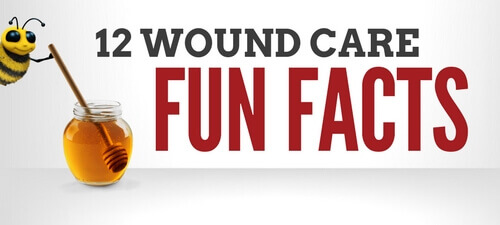Beer, honey and grease? The history of wound care includes all three, and much more. Go ahead … amaze your friends and colleagues with these wound care fun facts.
We’ve come a long way in wound care, especially over the past 100 years or so. But wound care techniques are as old as humankind, with the first wound treatments being described five millennia ago.
And while electronics and advanced technology have made an enormous impact in the way we treat wounds, ancient wound care practices helped pave the way. Take a look at 12 of our favorite wound care fun facts.
- A clay tablet dating back to 2200 BC is one of the oldest medical manuscripts known to man. It describes the “three healing gestures” – washing wounds, making plasters (today’s wound dressings), and bandaging wounds. Plasters were made from a number of materials, including clay or mud, herbs and plants.
- Oil was another common ingredient used in plasters, and provided some protection against infection. Oil would have also prevented the bandage from sticking to the wound.
- Beer was used as a healing agent by the Sumerians – they brewed at least 19 different types. One such prescription in Mesopotamian culture included these instructions: “Pound together fur-turpentine, pine-turpentine, tamarisk, daisy, flour of inninnu strain; mix in milk and beer in a small copper pan; spread on skin; bind on him, and he shall recover.”
- The first people to apply honey to wounds were Egyptians. They were also most likely the first people to use adhesive bandages.
- The most common plaster used by Egyptians was made from honey, grease and lint. Lint (made from vegetable fiber) most likely helped drain the wound, while grease and honey may have protected the wound from infection.
- Egyptians painted wounds with green color, symbolizing life. Green paint also contains copper, which is toxic to bacteria.
- The Greeks were all about cleanliness, recommending the washing of wounds with clean water (often boiled first), vinegar (acetic acid), and wine.
- The Romans documented an early description of the “four cardinal signs of inflammation” – rubor, tumor, calor, et dolor(redness, swelling, heat, and pain).
- Hippocrates was known to treat ulcers with wine and cover them with fig leaves. He also recommended treating hemorrhoids with red-hot irons, “… and burn so as to leave none of the hemorrhoids unburnt, for you should burn them all up.”
- It is estimated that during the American Civil War, erysipelas (necrotizing infection of soft tissue) and tetanus accounted for over 17,000 deaths. Because compound fractures at the time almost invariably were associated with infection, amputation was the only option, despite a 25-90% risk of amputation stump infection.
- BAND-AID®Brand Adhesive Bandages made their first appearance on the market in 1920. The earliest versions were made by hand, measuring three inches wide and eighteen inches long. Their debut was less than impressive – only $3,000 worth were sold during the first year.
- Some cultures use large ants as suturing agents. How? An ant is first provoked so that it bites the edges of a wound, pulling them together. Then the insect’s body is removed, leaving behind the head which acts as a clamp and sutures the injury.
Tell Us More
Do you have any additional fun facts about wound care to share? Do you know any interesting wound care myths or legends that make for a good story? Let us know – leave all the funny, strange or gory details below.
Wound Care Education Institute® provides online and onsite courses in the fields of Skin, Wound, Diabetic and OstomyManagement. Health care professionals who meet the eligibility requirements may sit for the prestigious WCC®, DWC® and OMS national board certification examinations through the National Alliance of Wound Care and Ostomy® (NAWCO®). For more information see wcei.net.
What do you think?

